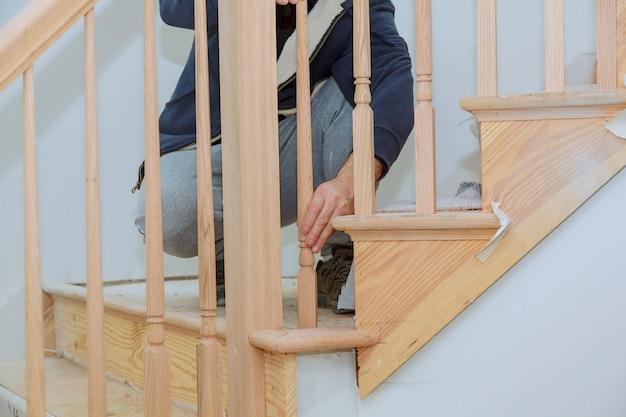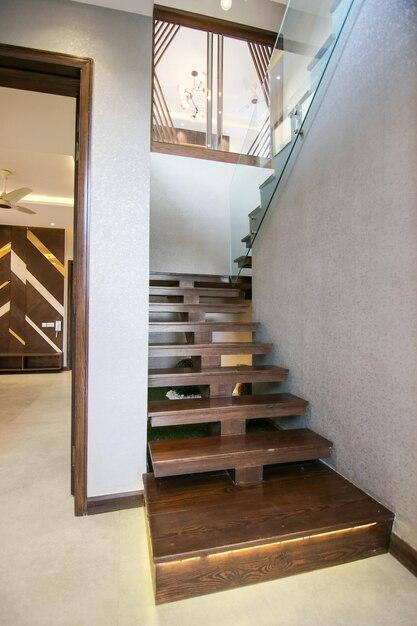Are you looking to add a touch of elegance and safety to your staircase or deck? Handrails are a fantastic addition that can transform the look of your space while providing much-needed support. However, cutting handrail ends can be a daunting task if you’re unsure of the proper techniques.
In this comprehensive guide, we’ll answer common questions such as the ideal degree for handrails, the required height according to codes and standards, and how to cut various handrail styles, including the infamous “pig’s ear” railing. Whether you’re a DIY enthusiast or a professional carpenter, we’ve got you covered with step-by-step instructions and helpful tips.
So, grab your tools and get ready to learn how to cut handrail ends like a pro. By the end of this guide, you’ll have all the knowledge needed to create beautiful and functional handrails that not only meet safety regulations but also enhance the overall aesthetics of your space. Let’s dive in!
How to Master the Art of Cutting Handrail Ends Like a Pro
Prepare Your Tools and Materials
Before diving into the exciting world of handrail end cutting, it’s crucial to gather all the necessary tools and materials. A trusty miter saw (sometimes called a chop saw or drop saw) will be your best friend for this job. Make sure it’s equipped with a fine-toothed blade for those clean and precise cuts. Don’t forget your safety goggles and ear protection because, let’s face it, no one wants sawdust in their eyes or a constant buzzing in their ears!
Measure Twice, Cut Once (Or Maybe Twice)
We all know the famous saying “measure twice, cut once.” But when it comes to cutting handrail ends, there’s no harm in measuring three times, just to be extra sure! Start by carefully measuring the length you want your handrail to be, keeping in mind any areas that may require angles or corners. Use a pencil to mark the exact spots where the cuts will take place, ensuring your measurements are as accurate as possible.
Embrace Your Inner Precision Ninja
Now that you have your measurements and marks, it’s time to unleash your inner precision ninja. Set your handrail securely in place on your workbench or sawhorses, making sure it won’t budge during the cutting process. Position your miter saw with the blade lined up precisely with your marked spot. Take a deep breath, steady your hands, and give that saw a gentle squeeze. Let the blade do the hard work as you guide it through the handrail with a smooth and steady motion.
Beware of Flying Splinters, They Have No Manners!
As you make those skillful slices through your handrail, keep in mind that flying splinters have no manners. They don’t think twice before landing in your eyes or sticking into your skin. So, socks with sandals might be a fashion statement in some circles, but safety goggles and gloves are your best accessories when cutting handrail ends. Trust us, a splinter-free face and hands will thank you later!
Sand Away Those Rough Edges
After the adrenaline rush of cutting handrail ends has subsided, it’s time to give those edges a little TLC. Grab a sanding block or sandpaper and smooth out any rough spots or imperfections. You want those ends to be as smooth as a freshly polished bowling ball. Take your time, applying light pressure, and let the sandpaper work its magic. Soon enough, you’ll have handrail ends that are velvety smooth, ready to be admired and touched by the hands of all who grace your stairway.
Embrace the Beauty of Finished Handrail Ends
Congratulations, you’ve conquered the art of cutting handrail ends! Step back and marvel at your handiwork. Admire those perfectly cut ends that bring a touch of elegance and safety to your staircase. You’ve mastered the precision cuts, tackled the flying splinters, and transformed rough edges into silky smoothness. Now it’s time to proudly showcase your newly finished handrail ends for all to see.
Now that you’re armed with the knowledge and skills to cut handrail ends like a pro, go forth and conquer the world of stairway beautification. Whether you’re enhancing your own home or offering your expertise to others, remember that precision, safety, and a touch of humor are the keys to success. So, grab that miter saw, put on your safety gear, and let your inner precision ninja shine!
FAQ: How To Cut Handrail Ends
Welcome to our comprehensive FAQ-style guide on cutting handrail ends. Here, we’ll provide answers to some common questions that DIY enthusiasts and aspiring handymen often have when it comes to this topic. Whether you’re pondering the correct degree for a handrail or the code requirements for handrails on stairs, we’ve got you covered!
What degree should a handrail be
When it comes to handrail angles, the most common and comfortable option is a slope of 32 to 36 degrees. This allows for a secure grip while ascending or descending stairs, providing both safety and support. So, aim for that sweet spot!
Are stairs 45 degrees
Not quite! While a 45-degree angle might sound tempting for your stairs, it’s not the recommended norm. Stairs are typically constructed with a standard angle of 37 degrees. This ensures a well-balanced and easily navigable ascent or descent.
What’s the height of a handrail
According to the International Building Code (IBC), handrails should be positioned at a height between 34 and 38 inches from the stair tread’s leading edge. This range ensures that the rail is easily reachable for individuals of varying heights.
What is code for handrails on stairs
The IBC specifies that handrails are a must-have for stairs consisting of more than three risers. These handrails should be accessible on both sides of the staircase and comply with height, width, and clearance requirements. Safety first!
What is the Australian standard for handrails
If you’re Down Under, the Australian Building Codes Board (ABCB) has your back. According to their standard AS 1657, handrails need to be installed on stairways with just two risers or more. The height, materials, and dimensions must also align with the given regulations.
What is the code for deck railings
When it comes to deck railings, the International Residential Code (IRC) sets the rules. In general, any deck elevated more than 30 inches above the ground necessitates a railing. Be sure to follow specific height, spacing, and material guidelines to ensure everyone’s safety and compliance with the code.
How far apart should handrail brackets be
To ensure maximum support and stability, handrail brackets should be installed at regular intervals. As a general rule of thumb, try spacing them approximately four to six feet apart. This spacing prevents any flexing or sagging of the handrail while providing ample reinforcement.
How do you cut a pig’s ear railing
Ah, the intriguing pig’s ear railing! To cut this ornate shape, you need a steady hand and a careful approach. Start by measuring the desired dimensions, marking the angles, and using a miter saw to make precise cuts. Don’t worry, no actual pigs were harmed in the process!
How do you cut corners on a deck
Cutting corners on a deck is an art that requires attention to detail. First, position your handrail appropriately, ensuring a secure fit. Then, mark the corners where the handrail meets using a speed square. Once marked, carefully cut along the lines using a miter saw or a hand saw. Voila! Your corners will be as sharp as your handyman skills.
What is the difference between a handrail and a stair rail
While the terms handrail and stair rail are often used interchangeably, there is a slight distinction. A handrail, as the name suggests, is designed to provide support for individuals navigating stairs. On the other hand, a stair rail refers to the entire assembly comprising the handrail, balusters, and newel posts. So, one is part of the other!
How do handrails on stairs keep you safe
Handrails play a crucial role in enhancing safety while traversing stairs. They provide stability, support, and balance, helping to prevent slips, falls, and potential injuries. Think of them as your trusty sidekick, always ready to lend a helping hand!
What is a pig’s ear handrail
Ah, the mysterious pig’s ear handrail makes another appearance! This unique style of handrail features decorative curves at each end, resembling the ears of, you guessed it, a pig. It adds a touch of character and charm to your staircase, elevating its visual appeal. Who said handrails couldn’t be fun?
How do you make handrails
Crafting your own handrail can be a rewarding endeavor. Start by selecting the desired material, be it wood, metal, or even composite. Then, carefully measure and cut the handrail to fit the appropriate length and angle. Finally, attach it securely to the balusters or newel posts to create a beautiful and functional handrail. You’ve got this!
Can handrails encroach on door clearances
Great question! The Americans with Disabilities Act (ADA) mandates that handrails should not encroach on the required clearance width for doors. This ensures easy access for individuals using mobility aids, like wheelchairs or walkers. Let’s keep those pathways open and obstacle-free!
How do you cut a handrail angle
To cut a handrail angle, follow these steps:
- Securely fasten your handrail in a comfortable working position.
- Measure and mark the desired angle using a protractor or a speed square.
- Utilize a miter saw to make accurate cuts according to your marked measurements.
- Smooth out any rough edges using sandpaper or a hand file.
- Admire your perfectly angled handrail – your precision is on point!
Can handrail be square
Indeed, handrails can indeed be square. While round handrails are more common, square handrails offer a modern and sleek aesthetic. Just ensure that the edges aren’t too sharp for both safety and comfort. Embrace the geometric charm of square handrails!
Do handrails need returns
Absolutely! Handrails without returns are like unfinished stories. Returns, generally referring to rounded, closed ends, are essential for safety. They prevent snagging on clothing or potential injuries caused by sharp edges. So, return those handrails to their complete and secure state!
Are handrails required on both sides of stairs
According to the IBC, handrails are typically required on both sides of stairs. However, there are exceptions. If the stairs are located against a wall and are not wider than 44 inches, a handrail on one side suffices. Always check and adhere to the specific regulations in your area for a safe and code-compliant installation.
How do I make a handrail return
To make a handrail return, follow these steps:
- Cut your handrail to the desired length, ensuring it extends past the last baluster.
- Measure and mark a point approximately 1.5 inches from the end of the handrail.
- Use a saw to carefully create a 45-degree cut from the outer edge of the handrail towards the mark.
- Repeat the process on the opposite corner of the same end.
- Finally, use sandpaper or a file to smooth out any rough edges. Your handrail return is now complete!
What side should handrails be on
In the United States, handrails are typically installed on the right side while ascending stairs. This convention ensures uniformity and consistency across residential and public buildings. Remember, it’s always right to be right!
What angle do you cut the end of a handrail
When cutting the end of a handrail, a 90-degree angle is typically the way to go. This square cut allows for a secure and flush attachment to newel posts or other supporting structures. Keep those angles sharp, my friend!
Can I use a 2×4 for a handrail
Technically, yes, you can use a 2×4 for a handrail. However, it’s important to consider the ergonomic aspect alongside safety and comfort. A 2×4 might not provide the ideal grip or aesthetic for a handrail, but hey, to each their own! Remember, personalization is key when it comes to DIY projects.

